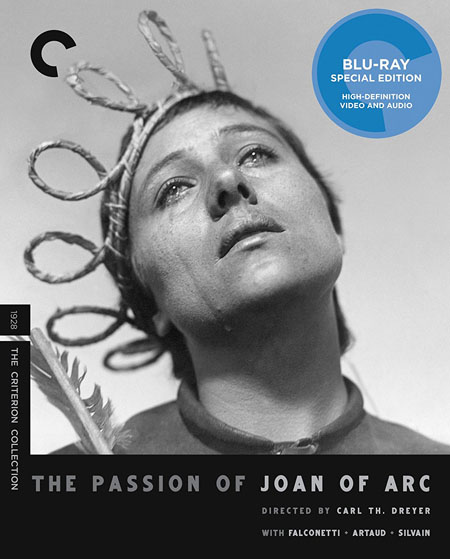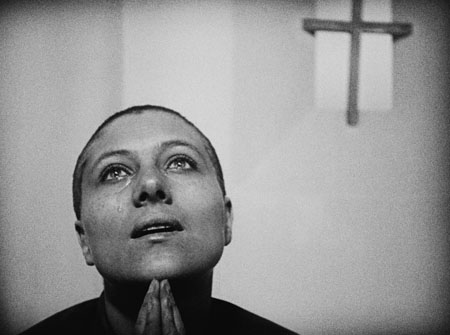
“THE BEAUTY OF
RAPTUREâ€
By Raymond Benson
Aside
from some of the comedy classics of the silent era, it’s arguable that the one
picture of the period you should make a point to see is Carl Th. Dreyer’s The Passion of Joan of Arc, a film that
has appeared on Sight and Sound’s top
ten films poll five times and consistently cited as one of the most essential
motion pictures in history.
That’s
high praise, and it’s deserved.
For
those of you who won’t watch silent movies because you think they’re boring or
slow or whatever—forget it. The
Passion of Joan of Arc is one of the most riveting pictures you’ll ever
see. Its brevity (only 81 minutes at 24
frames per second) is a strength, but its power lies in the faces of its
actors. Dreyer has focused the camera
(with superb cinematography by future Hollywood director Rudolph Maté)
on facial close-ups—the eyes, the mouths, the wrinkles in the skin… and it all
masterfully reveals the inner turmoil of the characters.
Especially
that of Joan. The performance by stage
actress Renée Jeanne Falconetti in the title role is
nothing short of miraculous. At the time
she was an acclaimed performer in the theatre to such an extent that her name
in the credits is simply listed as “Falconetti.†What eyes, what expressions, what pain… what passion! As she is overcome by the rapture that envelops her, Joan is transformed
to a thing of otherworldly beauty.
Anyone
familiar with Joan’s story knows what the film is about. Young Joan had led French armies against the
English during the Hundred Years’ War, was captured, and, because she claimed
to be able to speak with God, was put on trial for heresy by French clergy loyal to the English. The film depicts her trial and ultimate
execution.
Dreyer
adapted the actual handwritten court transcripts in writing the screenplay;
thus, the intertitles are real testimony delivered in the proceedings. The piece begins dramatically, with crowds
outside the court gathering to hear news of the trial. Sideshow performers and midway vendors turn
the thing into a circus. Inside, Joan is
led to confront a group of all-male judges who question her about her choice of
clothing (she dresses as a “boyâ€), her sexual orientation, her alleged
communication with the Lord, and if she’s really consorting with the
Devil. Joan has an intelligent,
reasonable answer for every question, but the judges have one goal in
mind. They move on to a torture interrogation
and finally the sad conclusion that would be the basis for Joan’s Sainthood.

The
Criterion Collection has upgraded their original DVD release with this
excellent Blu-ray, a new 2K digital restoration. All the original supplements are ported over
in high definition, but there are some new extras as well. For one thing, there are two versions of the
film here, whereas before there was only one. Viewers can choose to watch The
Passion at 24 frames per second (the way it’s historically been seen), or
at 20 frames per second (which some scholars claim is the way it was originally
shown). The latter version is about
twenty minutes longer. A new video essay
by film scholar Casper Tybjerg compares the two frame rates and provides pros
and cons for each. Personally, I prefer
the 24 fps version because I like the Voices
of Light score by Richard Einhorn (which accompanied the original Criterion
DVD). Here, though, you have a
choice—you can watch the film silently, with the Voices of Light score, or with a new modern score by Goldfrapp’s
Will Gregory and Portishead’s Adrian Utley. The 20 fps version comes with a piano score by Mie Yanashita. There’s
also a new interview with composer Einhorn, and one with Gregory and Utley. New English subtitle translations accompany
both versions of the picture.
Previous
supplements include an audio commentary from 1999 by Tybjerg; an interview from
1995 with Renée Falconetti’s daughter and biographer, Hélène
Falconeeti; a video essay about the various versions of the film over the
years; a production design archive; and a theatrical trailer. A new essay by
critic Mark Le Fanu, a 1929 director’s statement by Dreyer, and the full
libretto for Voices of Light are
inside the accompanying booklet.
The Passion of Joan
of Arc is
a class act for Dreyer, Falconetti, and for the Criterion Collection. It is a landmark presentation for a milestone
motion picture. Don’t miss it.
CLICK HERE TO ORDER FROM AMAZON
